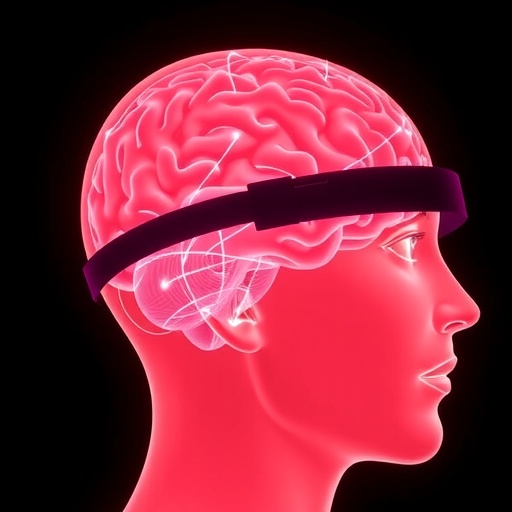In a groundbreaking advancement for neurological diagnostics, researchers have introduced a novel optical spectroscopy system designed to noninvasively measure blood flow in both the scalp and the brain. Blood flow dynamics are critical to understanding numerous neurological conditions, including strokes, migraines, and traumatic brain injuries. Yet until now, the major challenge has been effectively isolating cerebral blood flow signals from those of the scalp and skull, which both physically obstruct the brain and possess their own independent vascular networks, muddling measurement attempts.
This innovative technology, authored by a collaborative team spanning institutions such as the California Institute of Technology, University of Southern California, Rancho Research Institute, the University of Toledo, and Singapore’s National Neuroscience Institute, leverages the principle of laser speckle contrast optical spectroscopy (LSCOS). LSCOS works by illuminating tissue with coherent light to produce speckle patterns influenced by movement within the blood, which can be analyzed to infer flow dynamics. By tuning their system to discriminate depth, researchers can now differentiate superficial scalp blood flow from the deeper cerebral circulation noninvasively.
Central to this breakthrough is the experimental technique of temporarily occluding the superficial temporal artery, a major scalp artery branching near the temple. By briefly applying pressure to this vessel, the researchers observed significant alterations in the optical signals associated with scalp blood flow, while signals from deeper cerebral circulation remained stable. This method not only validates the device’s sensitivity and specificity but also establishes a practical framework for calibrating similar optical systems to tease apart overlapping vascular signals.
“Our system is a major step forward because it is the first to employ speckle contrast optical spectroscopy configured to effectively filter out scalp blood flow noise,” said lead author Max Huang. He emphasized that their occlusion technique provides a tangible, reproducible means for other researchers to benchmark the scalp versus brain sensitivity of their optical devices in real-world conditions, moving beyond purely theoretical or simulated calibrations.
Technically, the device is ingeniously compact and wearable, embedded into a headband that rests across the forehead. It integrates a coherent light source coupled with seven detectors positioned at increasing distances away from the artery. The proximity of each detector correlates with its depth sensitivity: those closer capture signals from superficial layers such as the scalp, and those farther away access deeper tissue signals, including brain blood flow. This spatial arrangement allows sophisticated computational models to parse superficial from cerebral signals with unprecedented resolution.
The data revealed that when the superficial temporal artery is gently compressed, signals detected at shallower depths dramatically diminish, confirming that these detectors specifically capture scalp blood flow. In contrast, detectors tuned to greater depths recorded consistent signals, conclusively demonstrating that the cerebral blood flow remains unaffected by this temporary blockage. This dichotomy is crucial, as it validates the device’s selective sensitivity to distinct vascular compartments.
Notably, the researchers acknowledged interindividual variability as a complicating factor in cerebrovascular monitoring. Differences in scalp and skull thickness among individuals can distort signal penetration and detection sensitivity, potentially biasing measurements. The new multisensor headband design accommodates such diversity by using the differential data from multiple detectors and occlusion tests, enabling a personalized calibration that improves accuracy and reliability across populations.
Looking ahead, the team is committed to advancing this technology with enhancements such as integrating sensors capable of direct skin contact, which would further improve signal fidelity and ease of use. Such innovations could propel this system toward widespread clinical deployment, offering a noninvasive, safe, and user-friendly tool for continuous cerebral blood flow monitoring—a pivotal asset for stroke management and brain injury assessment.
This pioneering approach not only opens new doors for neurological diagnostics but affirms the potential of speckle contrast optical spectroscopy as a game-changing technology in biomedical optics. By bridging the gap between superficial and cerebral blood flow measurement, the device delivers critical insights with profound implications for understanding and treating brain disorders.
The research, detailed in the article “Assessing human scalp and brain blood flow sensitivities via superficial temporal artery occlusion using speckle contrast optical spectroscopy,” formally appears in the October 21, 2025 issue of APL Bioengineering. The publication underscores the multidisciplinary collaboration and technological innovation that have culminated in this promising tool, primed to enhance both research and clinical landscapes.
In summary, this laser speckle contrast optical spectroscopy system embodies a leap forward in noninvasive cerebral hemodynamics monitoring. The amalgamation of experimental validation through artery occlusion, advanced multi-detector configurations, and adaptation to anatomical variability represents a meticulous and impactful approach. This technology heralds a new era where precise, real-time brain blood flow assessments could become routine in neurological healthcare and research settings.
Subject of Research: Measurement of scalp and brain blood flow sensitivities using noninvasive optical spectroscopy
Article Title: Assessing human scalp and brain blood flow sensitivities via superficial temporal artery occlusion using speckle contrast optical spectroscopy
News Publication Date: October 21, 2025
Web References: https://doi.org/10.1063/5.0263953
Image Credits: Huang et al.




